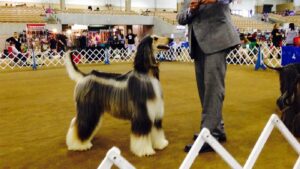
Judging the Afghan Hound
Harry Bennett, Afghan Hound Club of America Judges Education Coordinator, shares his insights on judging the Afghan Hound dog breed.

Home » Dog Breeds » Afghan Hound Dog Breed
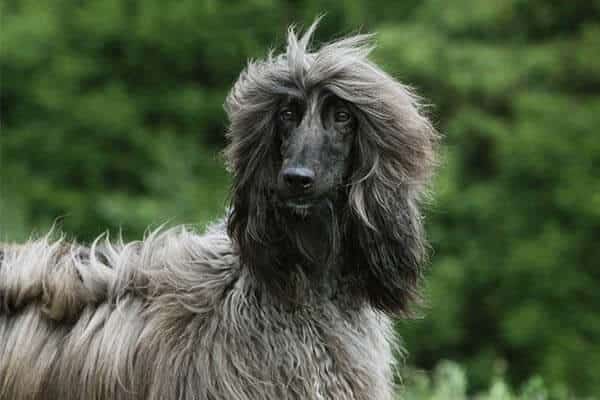
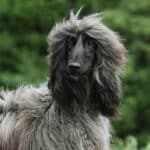
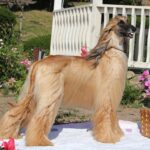
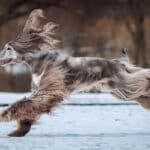
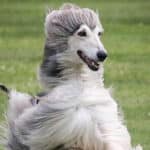
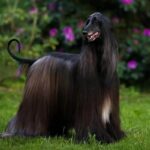
The Afghan Hound is an ancient breed of sighthound, recognizable for its aristocratic appearance, springy gait, and aloof disposition. Hailing from the cold mountain regions of Afghanistan and bred primarily for its hunting prowess, this “King of Dogs” has been renowned for millennia in the Heart of Asia for its keen sight, swiftness, and agility. Today, the breed is appreciated worldwide for its athleticism and affectionate nature, as well as for its undeniable allure, gracing the show ring, sprinting across open fields, and simply as an elegant and cherished companion in the home.
Hound
25 – 27 Inches
50 – 60 Pounds
12 – 18 Years
| Country of Origin | Afghanistan |
|---|---|
| Bred For | Hunting by Sight |
| Known For | Aristocratic Appearance, “Eastern” Expression, Elastic Gait, Independence |
| Popularity | Moderate |
| Temperament | Active, Affectionate, Alert |
| Activities | Hunting, Running, Hiking, Conformation Shows, Dog Sports |
The origins of the Afghan Hound can be traced back thousands of years, making it one of the most ancient of all breeds of dog. Originating from the mountain ranges of Afghanistan, these sighthounds were bred as hunters due to their keen eyesight, exceptional speed, and remarkable agility. Adept at chasing game across rugged terrain, often targeting ibex and leopards, the breed remains uniquely adapted to hunting prey in cold weather and harsh conditions.
For millennia, the Afghan remained relatively isolated, ensuring its purity. This isolation meant that, for much of its history, the dogs were largely unknown to the outside world. It wasn’t until the 19th century that the breed made its way to the West, introduced by British soldiers returning from the Indian-Afghan border wars. Captivated by the breed’s striking characteristics, enthusiasts quickly took up its cause, approving a Breed Standard and establishing individual breeding programs.
In the early 20th century, the Afghan Hound was introduced to the United States where it became an instant celebrity. The dogs’ proud carriage and “exotic” appearance soon captivated the nation, leading the American Kennel Club (AKC) to officially recognize the breed in 1926. That same year, The Royal Kennel Club in the United Kingdom bestowed the honor, and on the international stage, the Fédération Cynologique Internationale (FCI) gave the breed its official recognition in 1961. Today, wherever the Afghan Hound is found, it remains a symbol of dignity, grace, and enormously high style.
Adult male Afghan Hounds typically stand between 27 and 29 inches tall at the shoulder, while females generally range from 25 to 27 inches in height.
The Afghan’s weight usually ranges from 50 to 60 pounds.
The Afghan Hound presents a picture of strength and dignity, combining speed and power with an aristocratic air and an aloof indifference. The breed has a unique appearance, with an angular frame and a proudly elegant carriage. The ratio of height to length presents a dog that is neither too long in body nor too long on leg, with a somewhat square silhouette in profile.
Texture: The Afghan Hound’s peculiar coat is unique among sighthounds. It boasts a long, fine, and silky coat as well as a distinctive “patterning” of shorter, coarse hair on specific areas of the body. A shaggy topknot on the head is a distinctive breed feature, as are a beard and the “saddle” of short hair along the dog’s back. Short hair may also appear on the fronts of the pasterns. Puppy coats are typically “fluffy,” with facial whiskers that disappear within the first year, and the adult coat requires regular grooming to prevent mats from forming and to maintain its length and luster.
| Standard Color | |
|---|---|
| Black | ee |
| Black & Tan | ee |
| Black & Silver | ee |
| Blue | ee |
| Blue & Cream | ee |
| Cream | ee |
| Red | ee |
| Silver | ee |
| White | ee |
| Standard Marking | |
|---|---|
| Black Mask | ee |
| Brindle | ee |
| Brindle Black Mask | ee |
| Brindle Domino | ee |
| Domino | ee |
A Note About Color: Color and markings are not an important consideration in this striking sighthound, except that white markings, especially on the head, are not desirable.
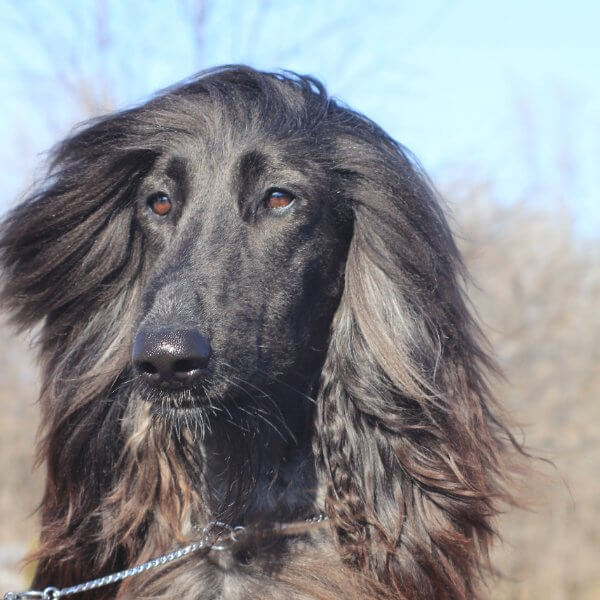
The tail of the Afghan Hound is a distinctive breed feature, reflecting this sighthound’s strength, balance, and elegance. Positioned not too high on the body, its most unique characteristic is the curve or ring on the end. When the dog is in motion, the tail is carried erect but should never curve forward or rest on the dog’s back, nor should it be carried to the right or left, or carried low. The tail is covered with hair and sparse feathering, but it should never have a bushy appearance.
Owning an Afghan Hound can be a rewarding experience, but it does require an appreciation for the breed’s unique characteristics and needs. With its flowing coat, this dog is not just a show-stopping beauty, it is also an efficient hunter that freely demonstrates its affection for family members. However, the breed’s aristocratic appearance and its dignified yet gay temperament come with a few requirements. Afghans need regular grooming to maintain their striking appearance and a safely secured environment for exercise and play.
The Afghan Hound is typically a healthy and robust dog; however, like all breeds and mixed breeds, individuals can be susceptible to a few health conditions. Prospective owners should be aware of these potential issues and work closely with a trusted breeder and veterinarian to ensure the dog maintains optimal health throughout its life.
Lifespan: The average lifespan for the breed ranges between 12 and 18 years, a testament to its overall vitality.
The Afghan Hound, while known for its exuberance and longevity, may still encounter a number of health challenges, including:
It’s essential for Afghan Hound owners to be familiar with these potential risks. Regular health screenings and observing any behavioral or physical changes in close collaboration with a trusted veterinarian and breeder can help to promptly address these and other conditions.
The Afghan Hound is more than a mere aristocratic beauty. This ancient hunter has a high prey drive and an intriguing personality as well, blending an independent nature and a sensitive soul in a uniquely appealing exterior. For novice dog owners, this singularity can be perplexing. However, the alluring Afghan will generally thrive in any environment that offers consistency and understanding, one that encourages connections that support the dog’s innate loyalty and desire to simply “be.” Although not considered a typically social breed by most standards, the Afghan Hound can get along well with visitors and other animals if socialized early and introduced with care. When it comes to children, these dogs can be gentle and patient, but it’s always important to supervise interactions and teach the youngsters how to approach the dog and treat it with respect. And just like a child, the Afghan Hound’s feelings always need to be considered, both at home and when interacting with other people and pets.
The Afghan Hound’s diet should be rich in high-quality protein sources, essential fatty acids, vitamins, and minerals. Throughout the first year, it’s important to provide a balanced diet designed for large-breed puppies, with the essential nutrients needed to support developing bones and joints. A feeding regime should be provided by the breeder, usually consisting of several small meals daily. For adults, the amount of food needed will depend on age, activity level, metabolism, and overall health. On average, a mature Afghan requires 2 to 2.5 cups of high-quality dry dog food daily, divided into two meals. Treats can be a useful tool for training, but too many can lead to obesity. Also, it’s essential to note that with its slender build and deep chest, the Afghan Hound can be susceptible to bloat. To minimize this risk, it’s advisable to feed smaller, more frequent meals and avoid vigorous activity right after mealtime.
Training an Afghan Hound presents a unique set of challenges and rewards. This breed is well-known for its independent nature, which can sometimes be mistaken for stubbornness. Yet despite the breed’s great intelligence and ability to grasp concepts quickly, success in training requires consistency and patience. Employing positive techniques is a must for this independent thinker. And although great intelligence is plainly evident, it does mean these dogs can become easily bored. This boredom can be expressed in several ways, most especially vocally. Thankfully, Afghans don’t typically bark without reason, usually alerting only to strangers or other perceived threats. Training from an early age can help with moderating any excessive vocalizations. A bored Afghan Hound may also want to wander, and as a sighthound, the breed’s prey drive can kick-in. For these reasons, a secure yard and leash training are absolutely essential.
The Afghan Hound has an inherent need for exercise rooted in its hunting origins. Ensuring an adequate amount of physical activity is vital for this breed’s mental and physical well-being.
| Energy Level | Moderate to High |
|---|---|
| Exercise Requirements | 2 Hours/Day (Minimum), Daily Walks, Vigorous Running, Regular Exercise, Playing with Another Dog, Mental Stimulation |
When it comes to exercise, the Afghan Hound has a good amount of energy to burn. Daily activity is crucial for maintaining optimal health and to prevent any undesirable behaviors that may result from boredom. Although the breed’s energy level is moderately high, this sighthound can exhibit surprising speed and agility. This means that, in addition to regular walks, Afghans will appreciate opportunities to run freely in a secure area. While these dogs may lounge regally indoors, they happily showcase their intensity if given the opportunity to run at full speed. Playfulness is another remarkable aspect of the breed, and the typical Afghan can be quite engaging. This joie de vivre, combined with the breed’s sensitivity, means the Afghan Hound often forms deep connections with members of their family.
The Afghan Hound’s stunning coat is one of its most distinctive features, cascading in silky locks that require consistent and attentive grooming to maintain its health and beauty.
| Coat Type | Thick, Silky, Fine Texture |
|---|---|
| Grooming Requirements | Daily Combing, Weekly Brushing, Frequent Bathing, Routine Ear Cleaning, Periodic Nail Trimming, Regular Tooth Brushing |
When it comes to grooming, the Afghan Hound is not a dog for the faint of heart. The breed’s long, fine hair can become tangled and matted without regular attention. A thorough brushing weekly with a pin brush can help to prevent tangles, making sure to check behind the ears, under the arms, and in other areas that are prone to matting. Regular brushing removes any dead hair and distributes the skin’s natural oils, promoting a healthy and shiny coat. Bathing isn’t needed frequently, only when the dog is particularly dirty. Additionally, regular ear cleaning, nail trimming, and dental care should also be part of the Afghan Hound’s grooming routine.
Afghan Hounds can blend seamlessly into a variety of lifestyles. However, there are certain considerations prospective owners should keep in mind to provide the best environment for this ancient breed. Afghans can adapt well to apartment living, provided the dog’s exercise needs are met daily. These dogs cherish moments of outdoor play, so access to a secure area is necessary. In cooler weather, the breed’s long, dense coat offers plenty of protection, but common sense is needed when temperatures dip below freezing. In warm weather, it’s crucial to avoid intense physical activity during the hottest parts of the day. Early morning and evening walks are best, and access to shade and fresh drinking water is essential. Afghan Hounds thrive on activity, but they do prefer a serene environment at home. Chaotic households can prove too unsettling for this sensitive and dignified dog.
There’s nothing quite like a litter of Afghan Hound puppies. With their natural curiosity and playful demeanor (not to mention their fuzzy faces), these colorful bundles of energy are sure to bring the family plenty of joy—and a bit of comic relief as well. Like all breeds of sighthound, however, the initial stages of life are critical for shaping each pup’s future disposition and behavior of an adult dog.
As the Afghan Hound puppy transitions to its new home, it is essential to provide a supportive environment that encourages confidence while setting boundaries. The focus should be on establishing routines. Regular feedings, potty breaks, playtime, and rest will help the puppy understand and adapt to its surroundings. Introducing a crate is also beneficial, offering a safe and secure space the pup can call its own. Good nutrition is essential throughout the initial growth phase, and it’s important to feed a high-quality puppy food recommended by the pup’s breeder or veterinarian. Socialization, even at this tender age, is vital too. While the Afghan pup may not be ready for extensive outings, exposure to different sounds, sights, and gentle handling can be enormously beneficial. Simple activities like playing soft music and inviting guests over for a visit can help to build the puppy’s confidence. Training sessions should commence early, focusing on basic commands and good manners. Short, engaging sessions with a positive focus work best for this breed. Of course, it’s never too early to start a grooming regime with an Afghan Hound. Gentle brushing, ear cleaning, and nail trimming at this time will acclimate the puppy to these necessary procedures.
The elegant Afghan Hound boasts a rich heritage rooted in athleticism and hunting prowess. As such, dogs of this breed can find fulfillment in a variety of activities and dog sports.
Engaging in these and other activities not only ensures the Afghan Hound remains physically fit, it also helps to keep the dog mentally stimulated. Whether competing at a high level or simply enjoying a game in the backyard, both the hound and its handler can benefit from the regular exercise as well as the shared experiences.
The Afghan Hound is recognized by the world’s leading registries and kennel organizations, which categorize the breed into a specific Group based on its unique characteristics. This breed is recognized worldwide under the following Group designations:
| Organization | Group Designation |
|---|---|
| AKC (American Kennel Club) | Hound |
| UKC (United Kennel Club) | Sighthound and Pariah Dog |
| CKC (Canadian Kennel Club) | Hounds |
| ANKC (Australian National Kennel Council) | Hounds |
| RKC (The Royal Kennel Club) | Hound |
| FCI (Fédération Cynologique Internationale) | Group 10: Sighthounds Section 1: Long-Haired or Fringed Sighthounds |
The ideal Afghan Hound is described by a Breed Standard that is approved by each of the world’s leading registries and kennel organizations. The Breed Standards for this breed may be found in the following links:
| Organization | Breed Standard |
|---|---|
| American Kennel Club | AKC Afghan Hound Breed Standard |
| United Kennel Club | UKC Afghan Hound Breed Standard |
| Canadian Kennel Club | CKC Afghan Hound Breed Standard |
| Australian National Kennel Council | ANKC Afghan Hound Breed Standard |
| The Royal Kennel Club | RKC Afghan Hound Breed Standard |
| Fédération Cynologique Internationale | FCI Afghan Hound Breed Standard |
Affiliation with a breed-specific club allows supporters of the Afghan Hound a chance to network and participate in events that promote the breed’s interests. Membership in these organizations grants access to a wealth of information, offering guidance on training, healthcare, and responsible breeding practices.
In the United States, the primary breed club is the Afghan Hound Club of America (AHCA). Founded in 1940, the AHCA has long been instrumental in promoting the breed, educating the public, and organizing specialty shows and social events.
In Canada, the Afghan Hound Club of Canada (AHCC) serves as the go-to organization, offering its members resources and support, and hosting a variety of events throughout the year that cater to anyone with an interest in the breed.
In the United Kingdom, the Afghan Hound Association (AHA), established in 1927, stands as the primary breed organization. With a rich history intertwined with the breed’s early recognition in the UK, the AHA has been at the forefront of Afghan Hound advocacy and education for nearly a century.
Membership in these clubs can come with numerous benefits, including access to exclusive events and educational seminars, and the opportunity to connect (and reconnect) with other Afghan Hound enthusiasts.
While the Afghan Hound is well known for its beauty, there are instances in which individual dogs can find themselves in need of a second chance. A variety of circumstances, such as owner relinquishment, unfortunate living conditions, or rescue from a puppy mill, can lead to an Afghan Hound requiring a new, loving home.
In the United States, organizations like the Afghan Hound Rescue of So. California endeavor to provide these majestic hounds with a pathway to a better life. The Afghan Hound Club of America, Inc. also has a rescue group that operates with the same commitment, placing any dog in need in a suitable home.
For those in Canada, the Afghan Hound Club of Canada occasionally works in tandem with rescue groups to help in the rehoming process and to support the welfare of the breed at large.
In the United Kingdom, the Afghan Hound Association (AHA) has an associated rescue group devoted to the breed. This group’s volunteers dedicate their efforts towards the care, rehabilitation, and rehoming of Afghans in need, ensuring they find loving homes where they can thrive.
Afghan Hounds are intelligent dogs with a rich history of hunting in rugged terrain, requiring keen instincts and wit. However, their intelligence is often paired with a strong sense of independence, which is sometimes mistaken for stubbornness. It’s important to approach their intelligence with understanding and patience, as they might not always respond in ways that are typical of more eager-to-please breeds.
No dog is truly hypoallergenic, and this includes the Afghan Hound. However, these dogs have a unique coat that produces fewer allergens compared to some other breeds. Their long, silky hair can trap dander, but potential owners with allergies should spend time with the breed first to determine individual reactions.
Yes, Afghan Hounds shed. While their long, flowing coat might give the impression they are heavy shedders, their shedding is moderate compared to many other breeds. Regular grooming and brushing can help to manage and reduce the amount of hair that’s left around the house.
By nature, Afghan Hounds are not aggressive dogs. They are typically dignified and somewhat reserved, especially with strangers. However, like all dogs, individual temperament can vary, so early socialization and consistent training are essential to ensure a well-adjusted and well-behaved hound.
Afghan Hounds, being sighthounds, have a strong prey drive. This means they might be inclined to chase smaller animals, including cats. However, if raised with cats from a young age and properly socialized, they can coexist peacefully. It’s essential to always supervise initial interactions between any dog and a cat.
Afghan Hounds are intelligent but also known for their independent nature, which can sometimes make training a challenge. They often require a patient and understanding hand, with training methods that are consistent and positive. Their sensitivity to harsh corrections means positive reinforcement techniques tend to work best.
While Afghan Hounds can be wary of strangers and may alert their owners to unfamiliar visitors, they aren’t typically aggressive or overly protective. Their primary role historically was hunting, not guarding. Thus, they might not be the first choice for those seeking a dedicated guard dog.
Afghan Hounds can make wonderful family companions for the right households. These are loyal dogs that typically form strong bonds with their families; however, the breed’s aloofness means they won’t be a good fit in every home, especially those with lots of guests. Proper socialization and understanding of the breed’s unique temperament are therefore essential.

Harry Bennett, Afghan Hound Club of America Judges Education Coordinator, shares his insights on judging the Afghan Hound dog breed.
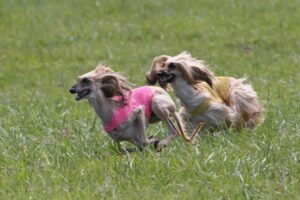
Eddie & Dr. Selma Kominek are the breeders behind Kominek Afghan Hounds. Read about the kennel’s beginnings, lure coursing, photos and more!
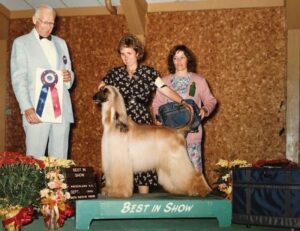
Sandra Frei is the breeder behind Stormhill Afghans. Read about the kennel’s beginnings, dogs, puppies, photos and more!
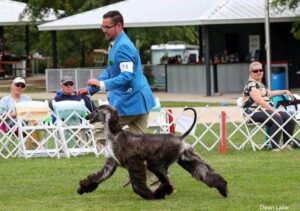
Athletic, aristocratic, and indelibly unique, the proper movement of the Afghan Hound can be one of its most misunderstood characteristics.
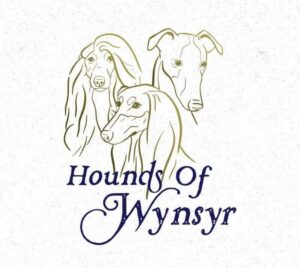
Interview with Hound Group Breeder D. Scott Pfeil – Wynsyr Kennels Where do I live? How many years in dogs? How many years
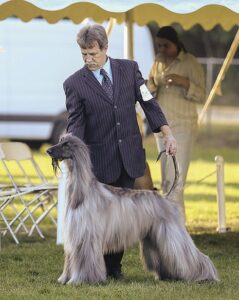
Stephen Williams | Afghan Hounds: I walked in the show ring for the very first time in 2014 at the encouragement of my dog’s breeder.

Dan Sayers is the Editor-in-Chief of SHOWSIGHT digital and print publications. He received a B.S. from Drexel University where he studied interior architectural design. His professional career has allowed him to develop his planning, problem-solving, and project management skills, which were employed in the office, educational, and financial sectors. While working as a project manager, he earned a Graphic Design Certificate from the University of the Arts and began creating ads for many of America’s top-winning show dogs. Through this work, Dan became Editor-in-Chief of the nation’s first online-only dog show publication. His current role expands on this experience and broadly extends to cover the sport of dogs in Companion and Performance events as well as all aspects of Conformation.
Dan is a long-time member of the Irish Water Spaniel Club of America and is the organization’s current AKC Delegate and Archivist/Historian, as well as a club-approved Breed Mentor. From 2000-2010, he was the club’s AKC Gazette Columnist. He breeds Irish Water Spaniels under the Quiet Storm prefix and has judged the IWSCA National Specialty Sweepstakes twice. Dan is a member of the Morris and Essex Kennel Club as well as the Dog Writers Association of America, which recognized his illustrations in the award-winning canine compendium, the Encyclopedia of K-9 Terminology.
The best way to ensure a long and happy relationship with a purebred dog is to purchase one from a responsible breeder. Not sure where to begin?
Contact the National Parent Club’s Breeder Referral Program, which is listed on the AKC Breeder Referral Contacts page.
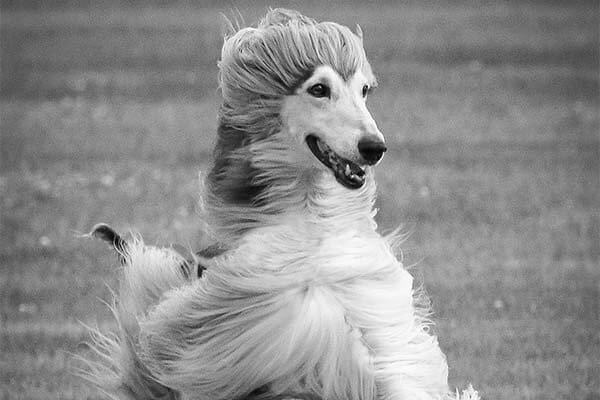

"*" indicates required fields
Showsight Magazine–the world’s most influential purebred dog publication since 1992. Each issue reaches a global audience dedicated to preserving the history and health of purpose bred dogs. Filled with award-winning editorial focused on news and insights from the dog show community, top breeders, handlers, AKC Judges, and more!